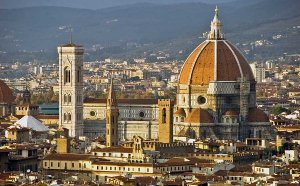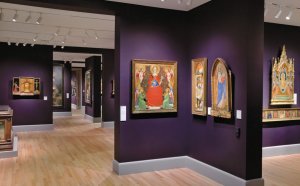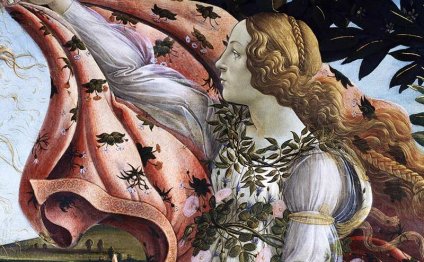
Early Italian Renaissance Artists
|
Greater Realism in Painting In keeping with the importance of Humanism, Early Renaissance painting strove to achieve greater realism in all their works. In contrast to the flat, stiff images of Byzantine art, faces now became more life-like, bodies were painted in more realistic postures and poses, and figures began to express real emotion. At the same time, great efforts were made to create realistic 'depth' in paintings, using scientific perspective. Although Giotto made advances in perspective, it wasn't until the arrival of the architects Brunelleschi and Leon Battista Alberti (14041472) that it was formalized as a creative technique and became a major preoccupation for many painters. Greater realism in fine art painting also necessitated proper study of light, shadow, and human anatomy. Although significant advances were made in these areas during the early and mid-15th century, it wasn't until the end of the century that light and shade was fully mastered by such great High Renaissance artists as Leonardo Da Vinci. For the best pictures, see Greatest Renaissance Paintings. For drawing, see: Best Renaissance Drawings. Subject matter also changed. Although most works were religious paintings illustrating Judeo-Christian stories from the Bible, Early Renaissance artists also introduced narratives and characters from Classical mythology, such as Venus and Mars, in order to illustrate their humanistic beliefs. It is noteworthy that whereas during earlier Medieval times, everything about Greek art and mythology was perceived as being pagan or associated with paganism, in the Renaissance it was identified with enlightenment. Sculpture In their quest for greater realism, Early Renaissance sculptors took inspiration directly from Classical Roman and Greek sculpture. But they were not slavish imitators. They imbued their free-standing figures with a range of emotions and filled them with energy and thought. Symbolism was often added to give extra meaning, in line with the new idea that sculptors (like painters) were the new creative intellectuals. The greatest sculptor of the period was Donatello (1386-1466), who along with the architect Filippo Brunelleschi and the painter Tommaso Masaccio made up the three dominant figures of the Florentine Renaissance. History of the Early Renaissance The Florence Baptistry The Early Renaissance began arguably in Florence in 1401. In that year, a contest was staged to decide who would be given the commission to create a pair of bronze doors for the Baptistry of St. John - one of the oldest surviving churches in the city. Seven sculptors were selected: each was to design a bronze panel depicting the story of the Sacrifice of Isaac. Of the entries, only two have survived: those by Lorenzo Ghiberti (1378-1455) and Brunelleschi. In each, key elements of the new Renaissance style are already unmistakably present. Ghiberti's submission, showing a muscular Isaac derived from Classical originals, won the competition and he was duly awarded the commission for the doors, which took him 27 years to finish. A second similar commission followed, detaining Ghiberti for another 25 years. However, his gates became a visible symbol of Florentine art, causing Michelangelo to refer to them the Gates of Paradise. The Brancacci Chapel In 1425, Tommaso Masaccio began painting a series of fresco paintings depicting the Life of St. Peter in the chapel of the Brancacci family, at the Santa Maria del Carmine Church in Florence. Masaccio's dignified monumental style - dramatic but stripped of all ornament - portrayed intensely real-life characters exuding dignity and self-assurance. His figure painting of Adam and Eve being expelled from Eden is famous for its realistic depiction of their bodies and heart-rendering emotion. In 1428, he left the chapel before the series was finished (it was later completed by Filippino Lippi), and died suddenly in Rome three months later at the age of 27. Although he left behind only a small number of works, they were considered milestones in the history of art, and inspired many artists throughout the quattrocento. In later years, the Brancacci Chapel frescoes became a sort of gallery and training school for painters, including Michelangelo Buonarroti, whose Sistine Chapel frescoes were greatly influenced by Masaccio's work. Perspective In addition to his bold realism, Masaccio was also the first painter to understand and use scientific perspective. In his Holy Trinity fresco, painted around 1428 in the church of Santa Maria Novella, Florence, Masaccio implemented some of Brunelleschi's ideas about linear perspective, and created a convincing illusion of a chapel - the first major example of linear perspective of the Renaissance. Perspective was taken up by many of Masaccio's contemporaries of Masaccio, including Paolo Uccello (1397-1475), whose works such as, (1438-40) and (1465-70), while dominated by artificial techniques of depth, still retain a joyous decorative enthusiasm. In this sense, Uccello combines International Gothic decoration with the more scientific Renaissance idiom. |
YOU MIGHT ALSO LIKE
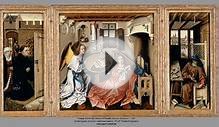
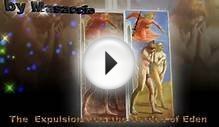
Share this Post
Related posts
Early Italian Renaissance Painting
According to Alberti s system all parts of a picture have a rational relationship with each other and to the spectator, for…
Read MoreEarly Italian Art
Typical Byzantine Mosaic 8th century. (w) We tend to assume that every age must be greater than the one that it preceded…
Read More
